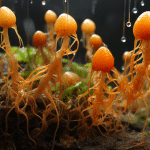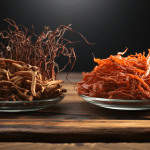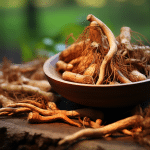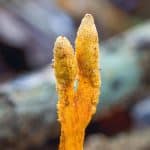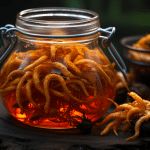The Ideal Cordyceps Militaris Substrate
Nearly all cordyceps militaris farmers use a supplemented rice (rice cooked with nutrient broth) substrate when growing in Mason jars or in trays/tubs. We do not recommend aluminum containers as the mushrooms will build up metals at an extreme rate.
History of Cordyceps Militaris Production
The science of growing mushrooms is in an early phase, which is particularly evident when looking at the timeline for production of the large scale, almost industrial-grade fungus, cordyceps. The species of Cordyceps militaris has been used for decades in eastern countries for supplementation, but has been cultured and sustainably cultivated in any systematic manner only since about 1895 .
Modern Cultivation of Cordyceps Militaris
The Challenges of Cordyceps Cultivation
Cordyceps has been used in Asia for decades as a supplement, but it has not been grown commercially in large quantities on a large scale in Asia until the 1980s. While the success of cultivation varies greatly depending on the species, Cordyceps mushrooms are famously hard to cultivate. While Ophiocordyceps sinensis is historically the most highly prized species of all the cordyceps, growing its fruiting bodies is drastically harder.
Overharvesting of this particular mushroom has led scientists to develop a way of growing the Ophiocordyceps sinensis mycelium in a bioreactor for use in supplement products. The primary strain that they developed, and still use, is called “CS-4”. When the DNA was analyzed, it was found that CS-4 was actually not Ophiocordyceps sinensis. Instead, it was a different mushroom called Paecilomyces hepialis.
To this day, that fungus is erroneously touted as a “cordyceps,” and we are desperate for a new alternative. This brings us to Ophiocordyceps militaris, a species which is favored for farming, and has many of the same compounds that Ophiocordyceps sinensis has. Cordyceps militaris provides similar health benefits, while being far more affordable and sustainably grown.
Cordyceps Militaris Production in the U.S.
The story of Cordyceps militaris substrate cultivation in the West begins in 1894, when Mrs. Greene cultured the first cordyceps militaris strains at Cornell University. A year later, in 1895, R. H. Pettit at Cornell published a research paper about the artificial farming of the species Cordyceps militaris, Cordyceps melolanthes, Cordyceps clavulala, Isaria farinosa, Isaria teniupes, and 11 related species (16 in all). By 1932, cordyceps was grown on rice, and from 1932 to today, most companies in the U.S. have grown Cordyceps mycelium on grains, without producing actual mushroom fruiting bodies. There are some anecdotes about farms growing mycelium and saying that they were accidentally producing mushrooms, but there has never been any published photos proving it.
The Cordyceps Militaris Cultivation Experiments Continue
Over the years, hundreds of experiments were conducted “failed” in the name of optimizing these mushrooms growing techniques, and we are still learning and improving methods for growing them. A company called Mushroom Revival, who we have promoted a few products from, is the largest, but also the first, and only, certified organic military-type cordyceps fruiting body farm in the western hemisphere. The recent rise in Cordyceps militaris mushroom farming around the world is increasing.
Cordyceps growing methods are distinct from the most common mushroom growing techniques. These techniques involve using grain manure, wood chips, and other farm wastes as substrates, as well as, sadly, the ubiquitous plastic bags.
Some companies are growing their own cordyceps militaris, right here in western Massachusetts, to make our own extracts. At Mushroom Revival, one of the companies we feature on Health By Mushrooms, their production methods of cordyceps militaris are continually evolving.
As our followers can see, they have started growing them in reused glass bottles. These proved to be successful, but they definitely added some clunkiness to the process. We moved on to growing in larger containers, a technique that we released to the public to copy by other farms, in this instructional video.
They are patient with our mushrooms, waiting to harvest when we have full-grown fruiting bodies, and then processing it to make our powerful, vibration-heavy, dietary supplements of cordyceps. They are also continually reading the latest science research to ensure that we are using the correct techniques and extraction methods, making sure that our products are delivering the highest number of active compounds possible. Mushroom Revival does not cut corners using fungi on grains, nor do they use any fillers or fuzz that will dilute the effectiveness of our end products. That’s why we are more than happy to promote their products as they are some of the highest quality on the market.
Mushrooms on a Mission
Dry cordyceps militaris has many uses. It is definitely great to use dried cordyceps the usual, obvious ways – like making a tea with it, making a tincture with it, or packing it in capsules. However you choose to use them, we think you will enjoy cordyceps. If you prefer the easiest way to consume cordyceps, try our 100% Organic tincture of cordyceps, made with just the fruiting bodies, and never the mycelium grown on grains. Cordyceps helps to support your bodys energy at a cellular level, so that you can continue tackling your to-do list throughout the day.
You can find our favorite capsules, powders, and tincture’s on the following pages of our website and learn more about each individually:
The Best Cordyceps Mushroom Gummies
Additional Resources:
Does Cordyceps increase libido?
Guide to the Cordyceps Mushroom
Updated 10/17/2022








